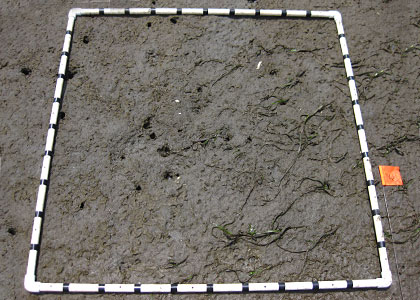|
|
 |
 |
|
|
 |
 |
 |
|
 |
|
Click on images to see larger
|
|
SEACOR began sampling the larger estuaries that support most of the recreational and commercial clamming areas in Oregon. So far we have sampled Coos, Tillamook, Yaquina and Netarts Bays. After sampling the larger bays, we will sample the smaller estuaries along the Oregon coast.
|  |
|
SEACOR began the shellfish and estuarine assessments in 2008. Like clamming, our sampling is governed by the tides and the light. We usually survey on early morning low tides with at least a -0.5 foot tide (below MLLW) to have enough time and space to sample. We sample each year from the spring into the late summer/early fall, when tides are at their lowest during daylight. Each of the four major clamming bays; Coos, Tillamook, Yaquina and Netarts Bays, will be sampled once every 10 years. Smaller estuaries will be sampled less frequently as time allows.
|
|
We use two sampling methods for our surveys:
|
|
At each site, we record habitat information within a 1m² quadrat (jpg) (a square that designates the sampled area). Habitat parameters include eelgrass and algae cover, substrate type, number and type of burrow holes, temperature, and depth of anoxic (low oxygen) layer.
Then we rake down to approximately 15 centimeters (six inches) looking for cockle or littleneck clams. Starting in 2010, we began to collect above-ground eelgrass biomass and sediment samples to evaluate grain size and the total organic content of clam habitat. |
 |
| An example of a 1m² quadrat – note the butter clam and gaper clam holes |
|
 |
| SEACOR biologists sorting clams |
After RAM sampling is complete, we revisit some of our sample locations to conduct in-depth DAM sampling. In this type of sampling, we collect all shellfish from the site by digging or megacoring. DAM sampling tells us how many clams are actually in that area, beyond just the ones with visible burrow holes at the surface. We measure and weigh all the shellfish we find. We use these data to learn more about the structure and distribution of the clam populations. This sampling method is time consuming so we sample fewer sites than when conducting RAM sampling. However, the DAM sampling provides more detailed data on clams that we then use in combination with RAM sampling data to estimate the abundance of the clams throughout our study regions.
|
 |
| SEACOR biologists measuring clams |
|
One method to collect DAM samples is to megacore using a Venturi suction pump (jpg). The pump sucks water up an intake hose and down the discharge hose to the venturi head. The water flow creates a vacuum strong enough to suck sediment up the suction hose. Any shellfish that are in the sediment will be collected in the mesh bag that is clamped at the end of the suction hose. To operate the suction system, two people stand in knee-to-waist deep water with one holding the suction end of the hose in the sampling area and the other holding the end near the collection bag. One additional person stands in the boat to operate the pump. Compared to hand digging clams, the megacoring system allows us to collect clams more efficiently. Digging the clams can be more time consuming and time restricted since we would only be able to dig samples during negative low tide days, which are limited. However, we can use the megacoring system during other tide periods. With the time we save by using this system, we are able to sample more locations, collect more clams, and get a better understanding of the clam populations in the bay.
|
 |
| megacoring a site |
|
|
While megacoring is our preferred method to collect clams, occasionally we do hand dig clams. It is almost impossible to use the megacoring system in areas that have a lot of gravel and cobble, so we modify our collection methods to dig out a 1 m² quadrat to a depth of 35 cm (jpg). We fill our holes once they are completed.
Sample Site Types |
 |
| SEACOR team digging a site |
|
 |
| A sandy site that can be megacored |
 |
| • A site with cobble that must be dug |
|
|
 |
| Subtidal Diver |
|
|
Contact the SEACOR project via e-mail at:
ODFW.SEACOR@odfw.oregon.gov |
|
 |
|
 |
|

